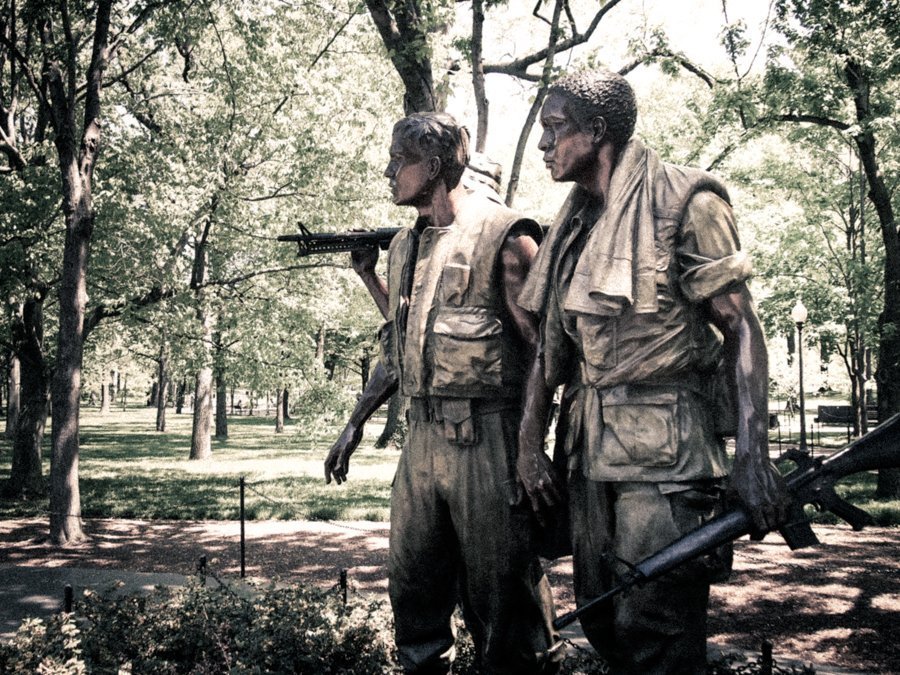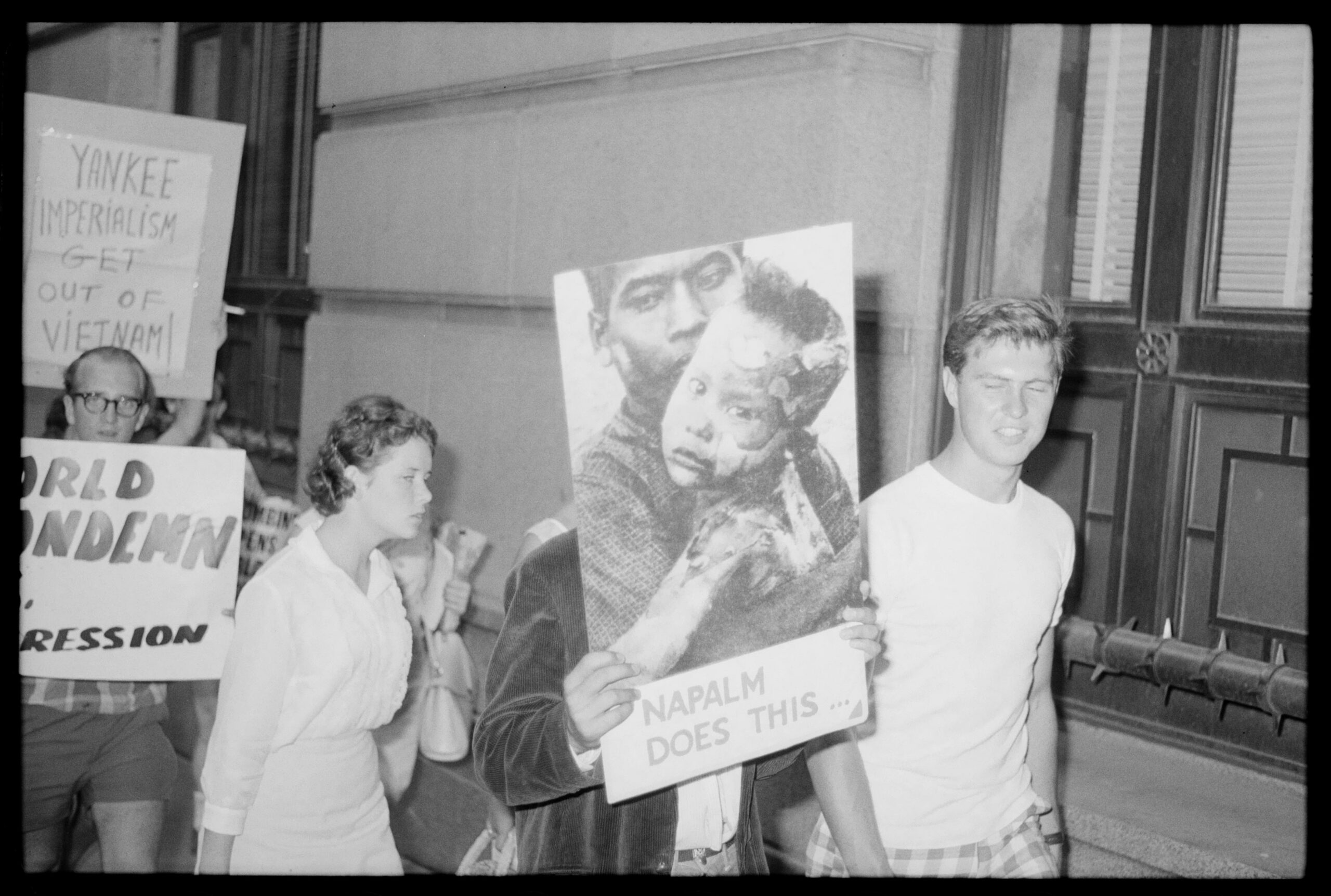Into the fire
It was the height of the Cold War. While the United States and the Soviet Union were engaged in what was maybe the deadliest staring contest in human history, the real wars were being fought on the periphery of the blocks of power. The communist doctrine of ‘national liberation’ was gaining traction in post-colonial Southeast Asia and the US Government was fearful that a domino-effect might push more countries into the communist sphere.
US involvement in Vietnam began in 1961, as Soviet and US ideologies split that country into two camps. The communist north began waging an armed insurgency against the republican south. Despite President John F. Kennedy’s promise to “win the hearts and minds” of the Vietnamese population, he also went straight to sending in special forces to train the South Vietnamese Army. The insurgency became more and more violent, and American forces were dragged into a military conflict that gradually evolved into full on war. A war that grew ever uglier.
For the US and its allies, warfare had been straightforward and quite linear in the past. The engagements in the Second World War, the fighting in Europe and the Pacific, and soon after that in Korea, had presented them with fixed lines and coherent battlefields. They took pride in the statement that they could fight any enemy, anywhere in the world.
The end of traditional tactics
The war in Vietnam, however, was to be the place where many of the traditional tactical approaches to war stopped working. It is often portrayed as the prime example of ‘guerilla warfare’, because of North Vietnam’s heavy reliance on the irregular forces of the Vietcong, the National Liberation Front. The Vietcong’s aim was to subvert the south by controlling the rural population, often through brutal terror tactics. They wore no uniforms, nor did they have standardised equipment, and instead preferred ambushes and traps to conventional warfare. The western coalition faced an enemy that seemingly had no headquarters, who did not even try to compete with them for superiority in the air or at sea. An enemy that deliberately chose to remain elusive, who would not stand and fight, but shoot at them from afar and then run. While the US could conduct devastating bombing runs deep into the north of Vietnam, their true enemy controlled the terrain beneath the tree-tops via a large network of tunnels, or fled into sanctuaries in neighbouring Laos and Cambodia.
It was clear that the western forces could not just stay in their bases and bomb their enemies from the air. They would have to conduct aggressive combat operations themselves to destroy the enemy’s forces, disrupt their logistics and break their power over the rural population.
Diverse terrain and weather

The supporting Australian forces already followed an especially aggressive doctrine of nearly non-stop patrolling to control and dominate the countryside around their base camps, and the US troops followed suit. The nation’s countryside, however, was a whole different matter. From open rice-paddies to tree-covered ridges, to the winding valleys of the mountainous regions in the south, the terrain of Vietnam was quite difficult to navigate. The plateaus of the Central Highlands are very different from the marshes of the Mekong Delta, but it was the jungle that really defined combat in Vietnam more than anything. There, it came down to individual platoons scouring the thick and hostile jungle, trying to establish control over the enemy.
In the jungle it was often eerily quiet. If not for the noise of helicopters flying overhead, or from distant artillery shells, there was little noise. Movement would therefore be reduced to a minimum, as every moving leaf or cracking twig could warn the enemy of their presence. With poor visibility, men could sometimes only see two or three men in front of them. In dense terrain, the platoons split up in even smaller groups. They moved slowly, covering each other. Trails were nearly invisible, overgrown by vines and brush. Every step, they had to carefully scan their surroundings, looking for moving vegetation or a colour that did not belong. There was this constant need for vigilance, as light and shadow could easily play tricks on their minds. In the thick, layered vegetation, the best thing for the enemy was to camouflage its position and lay an ambush. Being unaware for just a moment or letting your guard down just once could be a fatal mistake.
Of course, they weren’t only moving through jungle. The platoons could start out fast, moving over dry ground, then suddenly find themselves crawling through an area of thick bamboo. Then they would traverse the rushing waters of a stream; march through an exposed field of rice paddies; or be charging through man-high elephant grass.
Since the terrain was so diverse, it was impossible to calculate how long a unit would be ‘busting brush’ to reach its destination. Daily stress from the constant need to remain alert was exhausting, and the few hours of sleep each night in combination with guard duty, wore the men down quickly. Water was often scarce and rations were insufficient. Moving through the jungle was also draining. Temperatures changed from extreme to extreme depending on the season. Either it was too hot and too humid, or it was too wet once the monsoon season had set in. Heat exhaustion and dehydration were common among inexperienced soldiers, while mosquitos, leeches and snakes menaced them during the steady downpour in the swamps and marshes. Malaria, fever, dysentery, diarrhoea and even trench-foot were all daily dangers outside of combat. It wasn’t surprising that paranoia and the stress were often relieved with drugs.
As for what they carried with them, since the men were out in the field for several days on end, they had to be equipped with enough supplies and ammunition to keep them going, but resupply was often difficult and could only be done by helicopter. Therefore, everything had to be as light as possible.
A change in weaponry
The Vietnam war changed the deployment of weapons too. The standardisation of automatic rifles, such as the M16A1, was a confidence booster, especially in surprise engagement in the jungle, but also led to a higher demand for ammunition. Ammunition took priority over everything else. Jungle firefights were regularly lost by the side that ran out of bullets first. Bazookas and mortars were usually not carried into the dense jungle, since they were too heavy and unwieldy.
Once the sun was close to setting, the men had to stay close together. In the pitch black jungle, it was very easy to lose one another, and navigating the vegetation at night was pretty much impossible. Instead, they would stop and rest, and after it got dark, quickly change position once more. Sleeping was only possible for a few hours, as they constantly had to guard themselves and prepare their own ambushes throughout the night.
If the patrol survived the night and finally reached its destination, maybe a village or other populated area, it would investigate for Vietcong activity. Vietnamese interpreters accompanying the platoon would question the civilians, trying to get an accurate assessment of the situation. But trust was hard to come by. A village was full of ordinary people, woodcutters, fishermen and farmers. It was impossible to say if the Vietcong already had a grip on the local population. Were they sympathisers or just poor folk who minded their own business? Did they hide weapons or make booby-traps? The Vietcong often pressed villagers into service as lookouts, who would alert them of the platoon’s presence. Then the Vietcong would prepare their ambushes. It was not unusual to suddenly encounter the enemy on the trip back the same way they had come.
Once spotting an enemy, the silence was broken at once. The pointman would open fire, usually setting off a whole magazine into the enemy direction before backing up. The men behind would throw grenades or smoke bombs, as the cry: “Guns Up!” resonated through the ranks. Grenade launchers and M60 machine guns moved up to suppress the enemy, while the fighting would move to the critical flanks. It was vital to bring the maximum possible amount of firepower on the enemy’s position. If they were caught in the enemy’s killing zone, that was a death sentence. They often fired blind. If they were lucky, they got fleeting glimpses of their enemies, but even at close range, the vegetation could easily hide a whole platoon.
Streams of fire, highlighted by tracer rounds, ripped through the vegetation, from the belt-fed machine-guns. Grenades like the M67 ‘baseball’ were pretty much impossible to spot and throw back in the dense vegetation. Once the enemy had too much and sought to break off the engagement, the platoon would leapfrog onwards, trying to keep the enemy from slipping away. Immediately the radiomen would establish contact with base, relaying their position to call for support. If they were lucky, attack helicopters and bombers would swoop in, trying to cut the retreating enemy off and destroy them from the air. Napalm bombs were what was most feared.

A symbol of the Vietnam War
Napalm, more vicious than a flame-thrower, is a mixture of gasoline and a thickening agent. It’s a highly incendiary and sticky liquid that once aflame, clings to clothing or skin like burning glue, causing gruesome burns, and since it is a fluid, it can also flood into bunkers and tunnels. Where the Napalm bombs were dropped, the jungle was immediately set alight. It burned friend and foe alike, catching both civilians and combatants. Not only did it burn everything it came in contact with, its violent reaction with oxygen also meant it sucked all air out of its victims’ lungs, killing them through sheer pressure. The heat and asphyxiation killed people even if they weren’t hit directly. It cannot be washed off and is an unforgiving, tormenting killer.
Napalm became a symbol of the Vietnam War. But like the automatic weaponry, such as the thousands of bullets and the tons of bombs spent on each engagement, Napalm was just an attempt to catch the enemy. An enemy that did not care for instruction manuals or battle lines. Napalm symbolised the desire to kill an elusive and dangerous enemy by any means possible.
The Vietnam War heavily inspired our song ‘ Into The Fire ‘, which is featured on our album, Primo Victoria. Take a look at the lyrics we wrote here.
If you’re interested in a more visual interpretation of this story, watch our Sabaton History episode, Into The Fire – The Vietnam War:





















